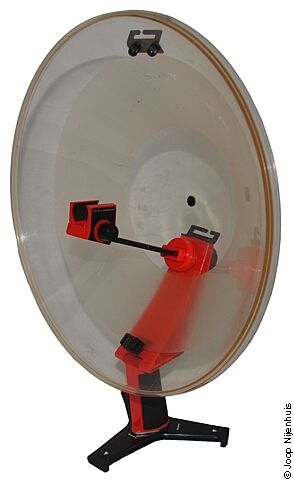Introduction

|
||
| Sony PBR-400 Parabolic Reflector | ||
A parabolic dish or reflector is an instrument that bundles incoming sound to the "focal point" in the dish. It must be a parabolic dish and not a hemisphere because with the latter it is not possible to get all the signals in that "focal point". The angle at which the signal enters is also the angle at which the signal leaves the surface. If that is not simultaneous, a signal will either be muted enormously or even cancel each other out. Due to this effect, the parabolic dish is enormously direction sensitive. The larger the dish, the greater the range. My largest dish has a range of approximately 30 km(!) for loud and low sounds. It is now no longer possible to work with this dish in the Netherlands, the interference signals have a too large part in the sound image. The parabolic dish from Sony shown here is easier to carry and has a much smaller range. However, this dish cannot always be used. Practice has shown that many birds and other animals see the dish as a large open mouth. The bird is then flown and other animals flee. A directional microphone then has a better effect, although these are sometimes mistaken for the barrel of a gun.
There are still parabolic dishes on the market, mainly all foreign suppliers. Availability is not always certain and sometimes you see conflicting messages on the internet when it comes to delivery. If you want to buy one you have to pay attention that it is a closed dish. A hole in the back, often seen, cannot remain open and must be closed because of trailing interference signals. It must also be ensured that you are not dependent on a type of microphone or microphone module from that supplier. It must be possible to use your own microphone. At the well-known microphone manufacturers have enough models that are suitable for use in a parabola. There are two reasons for your own type of microphone, the microphone must be suitable for the input impedance of your recorder and the power supply for the microphone is in your microphone or is external in the form of phantom power or pip, only the latter appears not be standardized.

|
|||
|
Frequency characteristic Sony PBR-400 Parabolic Reflector |
|||
revision July 30, 2020